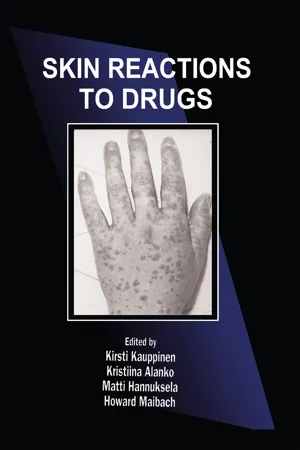1____________________________
Introduction
Kirsti Kauppinen
Side-effects of drugs cannot be avoided. Neither in vitro nor animal tests prior to the clinical use are usually useful in predicting probable hypersensitive reactions to drugs. In addition, clinical trials cannot identify those drugs that cause adverse reactions only in a small number of users or after prolonged and recurrent administration.1 Interactions of drugs ingested simultaneously may also be unexpected and an individual response to a drug is often unpredictable.
Adverse effects of drugs are mediated by different pathomechanisms and many organs such as lungs, kidneys, liver, and bone marrow can be involved. Skin reactions are the most frequent manifestation of drug sensitivity.2 Hypersensitivity reactions are dose dependent as has been stated in reports of drug challenge.3,4
Since the drugs in current use may vary between countries and also in time, lists of the most common drugs causing eruptions may not be valid for long. However, the drugs that cause the most frequent and most severe adverse reactions are eventually globally abandoned but usually only after several years.
The incidence of adverse reactions specific to a drug will generally be related to the frequency of a drug prescribed and the total amount of it used. Some drugs, however, are more prone to provoke side effects than others. For example sulfonamides, especially the long-acting products, have been incriminated for inducing severe mucocutaneous eruptions for decades. Thus, at present their use is greatly diminished, and the frequency of Stevens-Johnson syndrome and toxic epidermal necrolysis caused by sulfonamides has also remarkably decreased (see Table 1).3,5,6,7 In a series of 1426 patients from 1961 to 1990, antimicrobial agents, non-steroidal anti-inflammatory drugs (NSAIDS), and drugs acting on the central nervous system were the main groups of causative drugs over the years.3,5,6,7 Skin manifestation is usually the only sign of drug sensitivity, but it may be accompanied by general symptoms such as fever and malaise. In severe cases different organs may also be involved.
Distinguishing the origin of an eruption by a clinical picture is usually not possible because similar skin reactions may also be caused by various infections. Moreover, it is impossible to prove that a certain drug is responsible for a skin reaction by inspection alone.4
Incidence of skin reactions per dose is difficult to estimate because mild and transitory eruptions are not reported to the monitoring agencies. In contrast, some reports may be falsely attributed to drugs.
In this textbook, 12 of the most common drug eruptions have been described both clinically and histologically. The chapter of systemic contact dermatitis is included for the first time in a textbook concerning skin reactions to drugs. In addition, attention has been paid to cutaneous adverse drug reactions appearing in HIV-infected patients. New diagnostic methods, having been poor previously, are developed continuously. Studies on both skin testing and in vitro tests are in progress. However, a drug challenge is, thus far, the most reliable method to confirm a causative agent. It is relatively safe when performed rationally and with caution.4
1. Breathnach, S. and Hintner, H., Adverse Drug Reactions and the Skin, Blackwell Scientific Publications, Oxford, 1992, 3.
2. Sherman, W. B., Drug allergy, S Med J, 64, 22, 1971.
3. Kauppinen, K., Cutaneous reactions to drugs with special reference to severe bullous mucocutaneous eruptions and sulphonamides. Acta Derm Venereol (Stockh.), 52, suppl. 68, 1972.
4. Kauppinen, K. and Alanko., K., Oral provocation: Uses, Semin Dermatol, 8, 187, 1989.
5. Kauppinen, K. and Stubb, S., Drug eruptions, causative agents and clinical types, a series of in-patients during 10-year period, Acta Derm Venereol (Stockh.), 64, 320, 1984.
6. Alanko, K., Stubb, S., and Kauppinen, K., Cutaneous drug reactions, clinical types and causative agents, Acta Derm Venereol (Stockh.), 69, 223, 1989.
7. Stubb, S., Heikkilä, H., and Kauppinen, K., Cutaneous reactions to drugs, a series of in-patients during a five-year period, Acta Derm Venereol (Stockh.), 74, 289, 1994.
2____________________________
Epidemiology of Severe Cutaneous Drug Reactions
Maja Mockenhaupt and Erwin Schöpf
2.1 Introduction
2.2 Definition of the Diseases and Diagnostic Criteria
2.2.1 Terminology and Type of Skin Lesions
2.2.2 Consensus Definition of Severe Skin Reactions
2.2.3 Mucosal Involvement
2.2.4 Sequelae
2.2.5 Histopathology
2.2.6 Differential Diagnoses
2.3 Pathogenetic Approaches
2.4 Epidemiology
2.4.1 Incidence and Demography
2.4.2 Etiologic Factors and Risk Estimation
References
A variety of cutaneous adverse reactions, leading from mild maculo-papular rashes to life-threatening conditions, may be caused by drugs. Erythroderma, exfoliative dermatitis, and acute generalized exanthematic pustulosis (AGEP) as well as blistering diseases such as pemphigus vulgaris, bullous pemphigoid, generalized bullous fixed drug eruption (GBFDE), Stevens-Johnson syndrome (SJS) and toxic epidermal necrolysis (TEN) are often drug-induced. For several decades mainly case reports and case series were published, whereas more recently epidemiologic studies have been undertaken, allowing presentation of reliable data on the incidence, demography, as well as the etiology of severe skin reactions. The pre-condition for these studies and the analysis of data was a consensus definition of the clinical classification of severe, mainly drug-induced skin reactions in the spectrum of Stevens-Johnson syndrome and toxic epidermal necrolysis.
2.2 DEFINITION OF THE DISEASES AND DIAGNOSTIC CRITERIA
2.2.1 Terminology and Type of Skin Lesions
In general, S...
